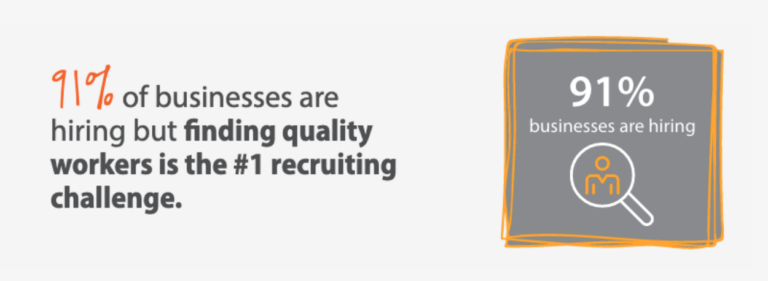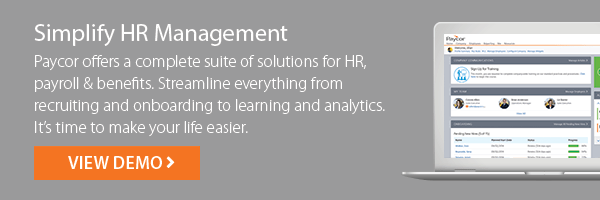The world of human resources is constantly evolving. Between job seekers with gig jobs like driving for Uber and high-tech advancements that enable remote work, employees have more power than ever. There’s a sustained desire to find a balance between work and life.
We also continue to see more job openings than available candidates, though this is slowly evening out. Job opportunities are abundant, meaning workers have fewer reasons to rely on and remain loyal to their employers. Especially if their employers don’t provide employee benefits and offer employees what they want.
For insights into trends in human resources, hiring, and workplace culture, Paycor recently conducted a survey of more than 7,000 HR, finance, and IT professionals. Ready on for key human resources statistics from our survey, or download the full report to dive into the future of HR.
Note: All statistics come from Paycor’s HR 2025 survey unless otherwise noted.
General HR Trends and Statistics
The landscape of human resources is constantly shifting, influenced by economic conditions, workforce changes, and evolving employee expectations. As HR professionals navigate these complexities, staying informed on key trends and data is crucial. Here are some current facts about HR.
- Nearly half (46%) of HR professionals have been in their roles for two years or less.
- The HR career outlook is good. U.S. Bureau of Labor Statistics show employment of human resources specialists is projected to grow 8 percent from 2023 to 2033, faster than the average for all occupations.
- According to Indeed data, HR specialists make $58,525 a year on average, while human resources managers earn $82,215.
- The median household income rose to $80,610 in 2023, the first annual increase since 2019 before the COVID-19 pandemic, according to a U.S. Census Bureau report.
- The average projected starting salary in the U.S. for the class of 2024 at the bachelor’s degree level is $68,516, according to a Bankrate analysis of NACE data.
- The same Bankrate study shows overall hiring projections for the class of 2024 are down 5.8% from last year.
- Gartner research shows 86% of HR leaders believe career paths at their organizations are unclear for many employees.
- As of 2024, 98% of organizations were leveraging online job training tools to educate their workforce, according to The Cloud Pulse.

Recruitment and Retention Statistics
As noted above, employee still struggle to find qualified workers. In addition, retaining employees is becoming a growing concern, as job seekers are increasingly drawn to flexible schedules, competitive salaries, and a healthy work-life balance. With more options available to workers, organizations must rethink their strategies to attract and keep their best talent.
- 91% of businesses are hiring. Across industries and company size, there is broad agreement on the top 5 recruiting challenges:
- Finding quality workers: 71%
- Convincing candidates to accept an offer: 15%
- Managing the hiring process: 10%
- Ability of onboarding to scale: 2%
- Ability to communicate to job seekers: 2%
- 20% of employees will actively search for a new job in the next 12 months.
- Employees who have been with a company for two years or less are 38% more likely to quit in the next 12 months.
- The most important factors respondents look for when considering a new job are:
- Better pay or benefits: 23%
- More flexible schedule: 15%
- Career growth: 14%
- The most important reasons employees stay at their current job are:
- Flexible schedule: 15%
- Salary and benefits: 14%
- Company culture: 14%
Leadership and Culture Statistics
You’ve probably heard the phrase, “people quit managers, not jobs.” If you want to improve recruitment and retention rates, focus on company culture and leadership. This starts with the hiring process and onboarding programs, which are an employee’s first impressions of your company culture. The statistics below highlight the critical connection between leadership effectiveness, company culture, and overall business outcomes.
- Employees who have been with a company for one year or less are 21% less likely to rate their leaders favorably.
- Compared to low-performing companies, employees who work for high-performing companies are 110% more likely to get productive feedback from their managers and 397% more likely to say their company’s senior leaders are engaged and inspirational.
- 83% of companies that report excellent financial performance over the last 12 months agreed or strongly agreed that their leaders were highly effective.
- 85% of companies with poor financial performance say their leaders are ineffective.
- Almost half (46%) of employees say their company does not have outstanding managers. 71% of C-suite executives agree.
- Newer employees (tenure of two years or less) are 21% less likely to rate their managers favorably.
Statistics on In-person, Hybrid, and Remote Workplaces
The shift from traditional office setups to hybrid and fully remote work models has transformed how companies engage with their employees. Each model comes with distinct advantages and challenges, especially when it comes to employee engagement, feedback, and leadership involvement.
As organizations continue to adapt, understanding the differences in employee experiences across workplace environments is crucial for refining management strategies and improving retention. The statistics below provide a snapshot of how hybrid, onsite, and remote workplaces compare in key areas of employee satisfaction and company performance.
- Gallup data shows 29% of employees with remote-ready jobs report they’re working fully remotely, and 52% are working a blend of in office and at home.
- 51% of employers with a hybrid model agree or strongly agree that their employees are highly engaged. 19% disagree or strongly disagree.
- 44% of employers with an onsite model agree or strongly agree that their employees are highly engaged. 24% disagree or strongly disagree.
- For fully remote workplaces, only 39% or employers agree or strongly agree that their employees are highly engaged. 26% disagree or strongly disagree.
- 56% of hybrid employees agree they receive productive feedback from their manager, compared to 50% of onsite employees and 39% of remote employees.
- 53% of hybrid employees feel they are paid fairly, while 50% of onsite employees and 38% of remote employees share this sentiment.
- 44% of hybrid employees believe leaders at their company are highly engaged, compared to 43% of onsite employees and 21% of remote employees.
- Remote workers are 34% less likely to quit than onsite workers, and 20% less likely than hybrid workers.
- Fully remote workplaces are 26% more confident they’ll meet their 12-month recruiting goals than onsite workplaces, and 10% more confident than hybrid workplaces.
- Remote workers who are actively searching for a new job are 55% more likely to be motivated by the desire to have a better relationship with their manager than onsite workers, and 50% more likely than hybrid workers.
Employee Engagement Statistics
Employee engagement is a key driver of business success, but many organizations continue to face challenges in maintaining high engagement levels. Engaged employees are more productive, committed, and contribute positively to overall company performance. However, the data suggests that disengagement is becoming more prevalent, and this trend has significant economic consequences. The following statistics illustrate the current state of employee engagement and highlight the impact of both high and low engagement on business outcomes.
- According to Gallup, employee engagement hit an 11-year low in early 2024, with only 30% of full-time and part-time employees reporting being highly engaged.
- In the first quarter of 2024, 17% of employees were actively disengaged, one point higher than the 16% for the full year of 2023, Gallup data shows.
- Actively disengaged employees, or loud quitters, hit 16% in 2023. 50% of workers were quiet quitting.
- Gallup estimates low employee engagement costs the global economy $8.9 trillion, or 9% of global GDP.
- There’s a 23% difference in profitability between highly engaged teams and teams with low engagement. Workplaces with higher engagement also report lower absenteeism, lower turnover, and lower customer engagement.
HR Technology and Automation Statistics
HR tech enables workplaces to enhance employee experience, gain efficiency, improve compliance, and more. Many agile companies leverage automation to streamline daily HR tasks, but a newer trend is the use of AI to augment decisions and enhance efficiency, particularly when it comes to recruitment. Read on for more HR tech trends.
- Fortune Business Insights reports the global HR technology market size is projected to grow from $40.45 billion in 2024 to $81.84 billion by 2032, showing a compound annual growth rate (CAGR) of 9.2%.
- Technology continues to be the highest-growing part of the HR budget, according to Gartner.
- 5% of HR professionals have already adopted generative AI into their organizations, while 9% are currently conducting generative AI trials, according to Fortune Business Insights.
- 20% of businesses will switch HR software providers in the next year. Paycor customers are 16% less likely to switch than companies that don’t use Paycor.
- Companies that use Paycor are 55% less likely to look for a new job in the next 12 months compared to employees of companies that don’t use Paycor.
- By switching to Paycor, our customers were able to streamline their businesses by reducing the number of HR tools and people management systems they were using by 184%.
How Paycor Helps
From employee experience and retention strategies to market conditions, the human resources landscape evolves rapidly. In addition to the human resource statistics listed in this article, Paycor’s HR in 2025 Guide provides insights and predictions into the future of the workplace, offering advice to help HR decision-makers stay ahead of the curve. Download the full guide here. Institute, Forbes, Harvard Business Review, LinkedIn, MetLife, Pew Research, SHRM, and the U.S. government, among others.










